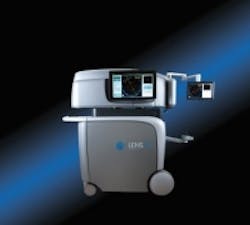Laser-based cataract surgery system features multiple machine vision cameras
Built specifically for refractive cataract surgery, The LENSAR Laser System is a femtosecond laser device that collects biometric data and reconstructs a 3D model of the anterior segment of the eye using a proprietary augmented reality technology.
Within the LENSAR’s augmented reality 3D imaging, measurement, and guidance system is an Adimec QUARTZ Qs-4A60 camera. The 4 MPixel Qs-4A60 camera features a CMV4000 CMOSIS global shutter CMOS image sensor with a 5.5 µm x 5.5 µm pixel size. The camera achieves a frame rate of 60 fps and features a dynamic range of 60 to 90dB as well as Camera Link and CoaXPress interfaces. Within the augmented reality system of the LENSAR, the Qs-4A60 rotates and captures anterior segment images and biometry at two different angles at up to eight different positions around the optical axis for a total of 16 potential images.
Multiple scans identify the precise location of the relevant anatomical structures from the anterior cornea to the posterior capsule, and using optical ray-tracing and biometric data, the augmented reality system creates a 3D model of each patient’s eye prior to surgery, allowing for more precise laser delivery. The technology also facilitates precise surgical incisions and treatment for ultimate accuracy and outcomes, all in a single procedure room, according to the press release.
In addition, an Adimec A-1000 camera is also used in the LENSAR Laser System for alignment and overview purposes during surgery. The 1MPixel A-1000 camera features a 2/3” Interline CCD image sensor with a 7.4 µm x 7.4 µm pixel size. The camera achieves a frame rate of 50 fps and features a dynamic range of 62dB as well as a Camera Link interface.
View more information on the LENSAR Laser System. View other articles from our July 2 3D imaging e-newsletter.
Also check out:
Embryoscope imaging device may improve chances of In Vitro Fertilization
Latest da Vinci robotic surgical system features enhanced capabilities
Vision system uses scorpion venom protein and a laser to identify tumors
Share your vision-related news by contacting James Carroll, Senior Web Editor, Vision Systems Design
To receive news like this in your inbox, click here.
Join our LinkedIn group | Like us on Facebook | Follow us on Twitter | Check us out on Google +
About the Author

James Carroll
Former VSD Editor James Carroll joined the team 2013. Carroll covered machine vision and imaging from numerous angles, including application stories, industry news, market updates, and new products. In addition to writing and editing articles, Carroll managed the Innovators Awards program and webcasts.
